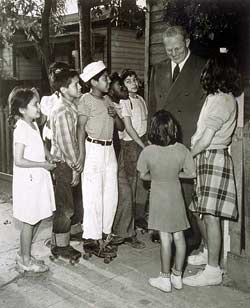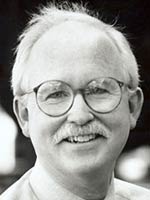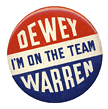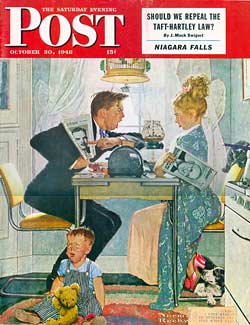Did Earl Warren wink?
There are some parallels between the GOP’s 1948 vice-presidential candidate and this year’s ... but the differences are what’s striking
| 22 October 2008
 California Gov. Earl Warren in 1946, greeting children outside his home in Los Angeles. (The Bancroft Library)
California Gov. Earl Warren in 1946, greeting children outside his home in Los Angeles. (The Bancroft Library)BERKELEY — The presidential race is on. The Republican nominee, a government insider, picks a maverick from a large Western state to be his running mate. Both parties go after the women’s vote. One of the candidates becomes a transformational national figure.
But in this election there are no hockey moms, no SNL appearances, and no First Dude.
 Bill Benemann
Bill Benemann The year is 1948. And the GOP running mate is Earl Warren, whom Bill Benemann, archivist at Berkeley’s School of Law, calls “our most significant graduate.”
Warren, who had earned both his undergraduate and legal degrees from Berkeley by 1914, was a popular and populist three-time California governor who went on to serve as a memorable chief justice of the U.S. Supreme Court.
In sync with the current presidential campaign, and to honor this famous graduate, Benemann has put together a small exhibit of 1948 campaign materials, news clippings, and other items pulled from his ever-expanding archive of Warreniana.
Occupying three display cases in the law library’s reading room, the exhibit has some fun with electoral politics of 60 years ago, and also hits themes still relevant today, especially the role of gender.
California Gov. Warren was tapped by New York Gov. Thomas Dewey to help him take on Democrats Harry S. Truman (president since 1945) and Alben Barkley, a Kentucky senator, in the race for the White House. So heavily favored were the Republicans, and so close was the vote, that the Chicago Daily Tribune, with just a few votes remaining to be counted, went to press late at night with the famous headline “Dewey Beats Truman.”
Well, not so much. It turned out to be the only election Earl Warren ever lost.
The notion of Warren as a “maverick” is woven through the history of the race. Benemann makes his case for the lighthearted comparison to current GOP veep candidate Sarah Palin — a parallel he admits is “uneasy.”

The term “maverick” wasn’t really attached to Warren at the time, Benemann says. But Warren was reform-minded and wildly popular. He brought geographic balance to the ticket, and California’s agricultural focus complemented Dewey’s New York industrialism. He was an outsider compared to Dewey, who as a two-time governor of New York (and his party’s presidential candidate in 1944) had a long record in government.
“And in most people’s minds, California was as distant from the rest of the country as Alaska is now,” Benemann points out.
The maverick label came later, when Warren emerged as a social liberal on the U.S. Supreme Court, taking part in a string of decisions that Benemann calls a watershed for the United States, including the landmark school-desegregation case, Brown v. Board of Education of Topeka. (Warren not only presided over that case but wrote the court’s decision.)
“That’s where I get the ‘maverick,’ ” says Benemann, whose archive contains an “Impeach Earl Warren” button from a 1960s campaign against the so-called activist judge.
President Dwight D. Eisenhower is often quoted as ruing Warren’s appointment (a tradeoff for Warren’s decision to pull out of the 1952 presidential race and throw his support to Ike) as “the biggest damn-fool mistake” he ever made, though Benemann thinks the story is apocryphal.
And a socially liberal Chief Justice Warren should not have been a surprise, he adds: “He was always on the side of the little guy.”

He says, she says
Gender politics, 1948-style, fills one case in the exhibit. Benemann’s take is that even as both sides wooed the women’s vote, the mainstream media saw women as “simpleminded homebodies” who lacked political minds of their own.
A case in point is on display: A Saturday Evening Post cover by Norman Rockwell shows a young couple at breakfast table. The pro-Dewey husband is haranguing his pro-Truman wife, who pouts but doesn’t try to argue her side. At their feet, a baby cries. Says Benemann, “Of course it’s the 1940s, so she’s the one neglecting the child, not him.”
In the same display is a newspaper clipping — a photo of “Mrs. Warren” with a caption that says, “She likes flower arranging, interior decorating, cooking. She is charming and efficient as an official hostess, but her main interests are domestic.”
Meanwhile, Benemann says, the “wimpy” candidates are sold as super-masculine. Dewey scores the cover of Physical Culture magazine and a feature about how he keeps fit.
In the other two cases are more general mementos, including a Dewey poster that lays out the issues of the day: taxes, debt reduction, small business, housing. Though 60 years have passed, some things never change.
Benemann’s Warren collection got its start when a staffer brought in a cache of research materials from a mid-1960s magazine profile of the then-jurist. He is constantly building the archive, mainly with items he finds on eBay.
Benemann mounts other exhibits from his archive as well. Earlier in the semester he featured the first women to earn their J.D.s from Berkeley, starting in 1906. All together, there were 120 by the end of World War II.
This is the second time Benemann has put some of his Warren material on display around election time. The first time was four years ago, but he has acquired two-thirds of the artifacts in his current display since then.
The archivist figures he can put up a Warren display to inform Berkeley’s law students every presidential-election year: “I’m lucky, because law school is only three years long.”

